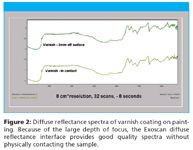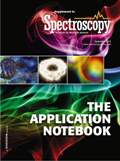Diffuse Reflectance Spectroscopy Using a Handheld FTIR
Application Notebook
As has been previously discussed (1), FTIR spectroscopy is emerging as a technique that can be effectively used for applications and/or in locations that heretofore would be considered too demanding. The development of portable FTIRs, and more recently handheld FTIRs, is significant because it enables this powerful analytical technique to solve problems for a whole range of new applications, both in the laboratory, and out of the laboratory.
Alan J. Rein, John Seelenbinder, and Frank Higgins, A2 Technologies
As has been previously discussed (1), FTIR spectroscopy is emerging as a technique that can be effectively used for applications and/or in locations that heretofore would be considered too demanding. The development of portable FTIRs, and more recently handheld FTIRs, is significant because it enables this powerful analytical technique to solve problems for a whole range of new applications, both in the laboratory, and out of the laboratory.
In order to effectively tackle these new applications, the hand-held FTIR must not only be stable, rugged and offer good performance, but also be equipped with the appropriate sampling interface. To date, virtually all portable or handheld FTIR spectrometers rely on ATR interfaces to handle applications in which the samples to be analyzed are either powders or liquids. These applications are often simple identification applications, typically for either analyzing unknown samples in homeland defense applications or for raw material quality control in pharmaceutical and chemical applications. However, there is a whole range of applications emerging for handheld FTIRs that require different sampling interfaces. For example, large solid objects as diverse as aircraft fuselages, wind turbine blades, and rare art cannot be effectively analyzed by ATR without excising a small sample and that negates the value of non-destructive analysis. For this reason a range of reflectance sampling interfaces have been designed for the Exoscan handheld FTIR that enable the system to tackle more diverse applications:
In a previous paper, the external reflectance, ATR, and grazing angle sampling systems were discussed. A new sampling interface using diffuse reflectance has recently been developed that tackles a broad range of applications.
Diffuse Reflectance Sampling Interface
The Exoscan diffuse reflectance sampling interface is designed to bring the infrared energy to the sample at a near normal incidence (Figure 1) and the scattered light is collected around the outside of the illumination cone. This is a more efficient collection mechanism for scattered light and it greatly reduces the amount of external reflectance observed (which results in negative spectral bands, if the sample measured is reflective or semi-reflective).

Figure 1
In many ways, the diffuse reflectance interface may be the most versatile and easiest to use of the sampling technologies for a handheld FTIR. Whereas ATR requires good contact with a sample, the large depth of field enables diffuse reflectance to yield good spectra without touching the sample (Figure 2). Getting good contact with ATR for powdered samples is easy when one has a lab system with a conventional pressure device that ensures good contact — not as easy when you have a handheld system and may have inconsistent pressure. Also, diffuse reflectance is less sample angle dependent than ATR and thus less sensitive to alignment with the surface. Thus, the new diffuse reflectance sample interface for the Exoscan system improves measurements on many types of solid samples (Figure 3).

Figure 2
In our testing, we have found very good results on a wide variety of samples including artwork, soils, rocks and minerals, rough plastics, carbon fiber composites, fabrics and corrosion on metal surfaces. Though there is an overlap between samples which can be analyzed with the external (45 degree) reflectance and diffuse reflectance interface, we have found that if the sample reflects little light, the diffuse reflectance interface will perform better. Also, the diffuse reflectance interface is less sensitive to focus at the sample than the external reflectance. On the other hand, the diffuse reflectance interface does not give good spectra for materials with highly reflective surfaces, since none of the light is diffusely scattered into the detector collection optics.

Figure 3
Application Examples for Handheld FTIR Equipped with Diffuse Reflectance Sampling Interface
A. Composite Analysis
Mid modulus, carbon fiber epoxy resin composites are finding ever-increasing use in commercial aircraft applications. We have carried out extensive work using the Exoscan to analyze damage caused by thermal stress to these classes of composite.
As a result of the manufacturing process, the outer surface of the composite has a higher ratio of resin component to carbon fiber (it is "resin rich") than does the sub-surface of the composite ("fiber rich"). The composite resin provides a strong IR spectrum; the carbon fiber does not have an observable spectrum. Therefore, the outer surface of composite provides a stronger overall IR spectrum than does the subsurface. In fact, either the external reflectance or diffuse reflectance spectrum of composite surface (Figure 4) is essentially equivalent with respect to absorbance-to-noise ratio.

Figure 4
When the external reflectance and diffuse reflectance infrared spectrum of the fiber rich sub-surface is recorded, a very different result occurs. In both cases, the baseline is sloped due to scattering of light by the carbon fiber, but, the external reflectance spectrum exhibits an absorbance-to-noise ratio considerably less than that of the diffuse reflectance measurement (Figure 5). Thus, we find that the Exoscan equipped with diffuse reflectance sampling interface provides higher quality spectra of the carbon fiber–rich subsurface than does the external reflectance method.

Figure 5
B. Soil
The concentration of certain inorganics in underlying soil can have an affect on the longevity of road surfaces. Thus, the Exoscan diffuse reflectance interface was used to determine the concentration of sulfate in soil for this application. We found that using the sulfate overtone bands in the 2300–2090 cm–1 region (Figure 6) provided a linear correlation for the amount of sulfate in soil in the relevant concentration ranges (Figure 7). The soil was measured by simply placing the Exoscan sampling interface in light contact with the soil. Diffuse reflectance measurements with the Exoscan can identify a variety of mineral components in soil and rocks, as well.

Figure 6
C. Rare Art
Mosaic tiles require a protective coating to prevent fading of their original gloss and color. Two tiles painted with ethyl silicate paint were measured via Exoscan diffuse reflectance. One tile had a single layer of a protective coating and the second had two layers of the protective coating. Both tiles were artificially weathered and this resulted in fading of the sample with the single coating application.

Figure 7
The diffuse reflectance IR spectra (Figure 8) of the coated mosaics reveal several differences. First, there is a shift in the carbonyl absorbance from 1745 cm–1 in the twice coated sample to 1738 cm–1 in the single coated sample. Also, the relative intensities of the bands at 1791 cm–1 and 2511 cm–1 are less in the single coated sample compared to the double coated sample.

Figure 8
Conclusion
Handheld spectrometers will enable FTIR to tackle new applications, industries and markets. However, just as in traditional lab systems, in order to accommodate these new opportunities, the correct sampling interface is critical to obtaining useful results. For this reason, the Exoscan handheld FTIR adds diffuse reflectance capabilities to its other reflectance methodologies and affords the user with a wide range of sampling options.

The combination of short internal pathlength, large aperture optics and optically coupled sampling interface enables the handheld Exoscan system to perform exceedingly well at its tasks. Additionally, this system is also offered with a docking station interface that permits dual use for the Exoscan — as a powerful lab instrument for methods development, and as an equally effective field instrument for the purpose of either gathering data for method development or to implement the finished method in the field.
References
(1) J. Seelenbinder, "Exoscan FTIR Instrument System Can Easily Be Used in the Lab or Taken to the Field for Routine Analysis," Spectroscopy — The Application Notebook, 14–15 (February 2009).

A2 Technologies
14 Commerce Drive, Danbury, CT 06810
Tel. (203) 312-1100, Fax (203) 312-1058
Website: www.a2technologies.com

Thermo Fisher Scientists Highlight the Latest Advances in Process Monitoring with Raman Spectroscopy
April 1st 2025In this exclusive Spectroscopy interview, John Richmond and Tom Dearing of Thermo Fisher Scientific discuss the company’s Raman technology and the latest trends for process monitoring across various applications.
A Seamless Trace Elemental Analysis Prescription for Quality Pharmaceuticals
March 31st 2025Quality assurance and quality control (QA/QC) are essential in pharmaceutical manufacturing to ensure compliance with standards like United States Pharmacopoeia <232> and ICH Q3D, as well as FDA regulations. Reliable and user-friendly testing solutions help QA/QC labs deliver precise trace elemental analyses while meeting throughput demands and data security requirements.